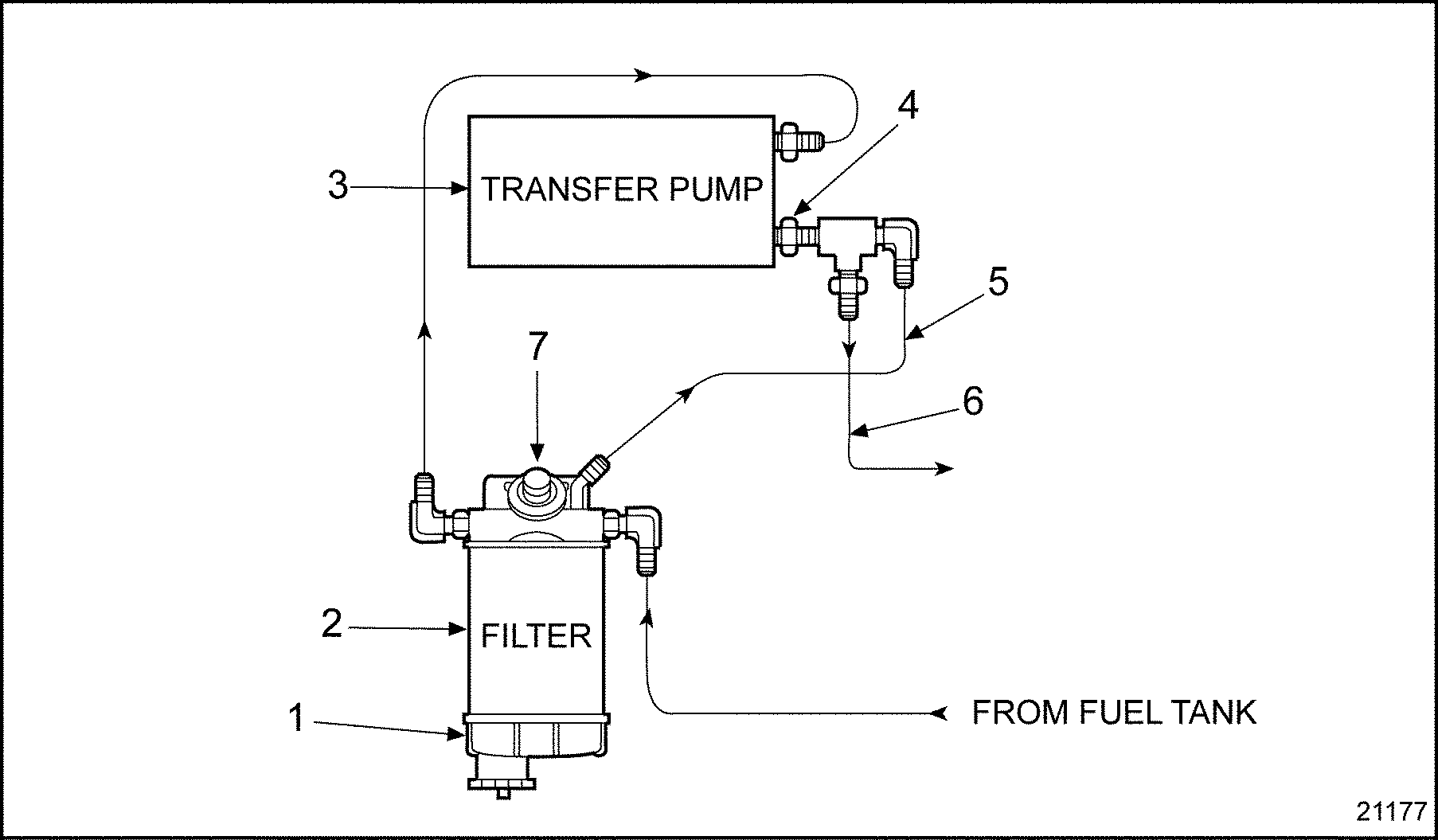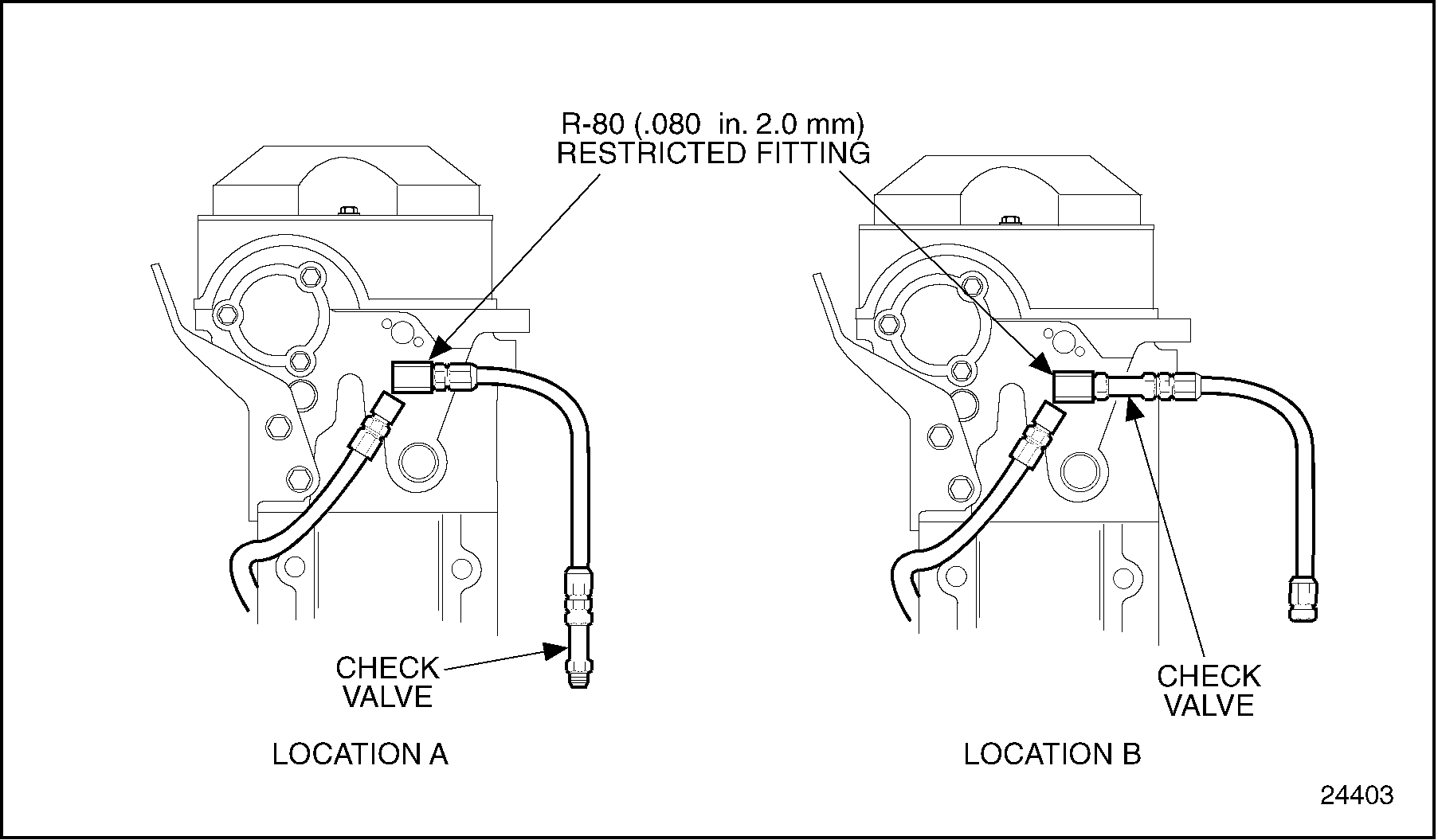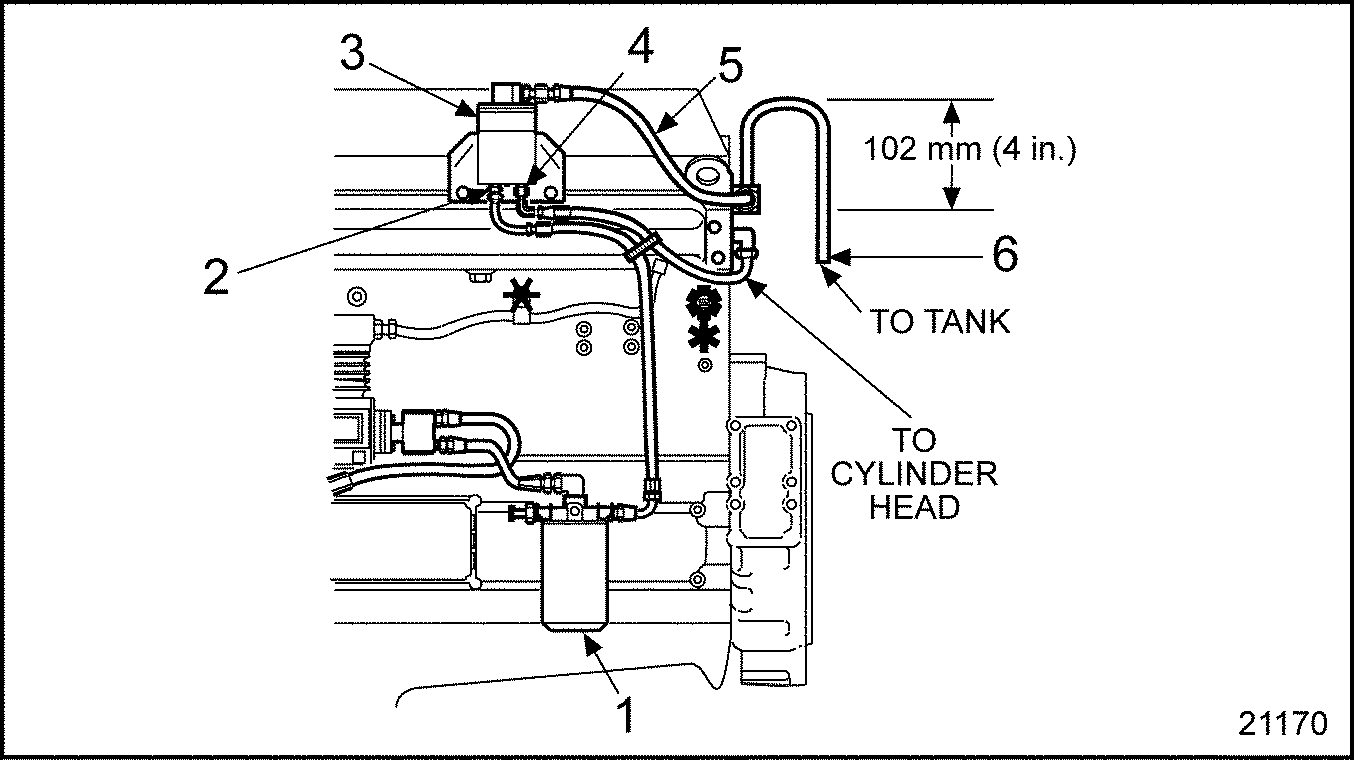Section 2.8
Fuel Filter and Water Separator Assembly
The fuel filter and water separator assembly facilitates the settling of water in a collection bowl. See Figure "Typical Fuel Filter/Water Separator Installation" .

|
1. Collection Bowl |
4. Reducer Bushing |
|
2. Spin-on Element |
5. Hose from Filter Head to Transfer Pump Discharge |
|
3. Priming Pump |
6. Hose to Secondary Fuel Filter |
Figure 1. Typical Fuel Filter/Water Separator Installation
Section 2.8.1
Replacement of Fuel and Water Separator Element
Replace the fuel and water separator element as follows:
- Drain off some fuel by opening the drain valve on the collection bowl. Close the valve.
- Remove the element and bowl together, then remove the bowl from the element. Clean the bowl and the O-ring gland.
- Apply a coating of clean fuel or grease to the new O-ring and element seal. Spin the bowl onto the new element and them spin the assembly onto the filter head by hand until snug. Do not use tools to tighten.
- To eliminate air from the filter, operate the primer pump until the fuel purges at the filter assembly.

PERSONAL INJURY
Diesel engine exhaust and some of its constituents are known to the State of California to cause cancer, birth defects, and other reproductive harm.
- Always start and operate an engine in a well ventilated area.
- If operating an engine in an enclosed area, vent the exhaust to the outside.
- Do not modify or tamper with the exhaust system or emission control system.
- Start the engine and check for fuel leaks. Correct any leaks with the engine shut off.
Section 2.8.2
Fuel Return System Check Valve
The purpose of the check valve is to reduce the risk of fuel prime loss and fuel siphoning from the head when the fuel filter is removed. See Figure "Typical Fuel Return Check Valve Locations" .

Figure 2. Typical Fuel Return Check Valve Locations
NOTICE: |
|
The check valve must be included in the fuel system. If the check valve is removed for any reason or found to be defective, a new valve must be installed and the fuel system primed before start-up. The R-80 2.032 mm (0.080 in.) restricted fitting (elbow connector) which is ahead of the check valve must also be included in the fuel system. |
NOTICE: |
|
Do not increase the size of the orifice in restricted fittings. Increasing restricted fitting hole size can cause injector cavitation, resulting in reduced durability of injectors and other engine components, and increased engine emissions. |
A check valve is connected to a hose in the fuel return line coming from the rear of the cylinder head or at the cylinder head restricted fitting, depending on individual installation requirements. See Figure "Typical Fuel Return Check Valve Locations" .
Section 2.8.3
Removal of PRO-CHEK ®
Fuel System Check Valve
Remove the valve as follows:
NOTICE: |
|
The PRO-CHEK ® fuel system check valve is installed after the secondary filter. Any dirt or debris entering the fuel system at this point may cause severe injector damage. |
- Clean the area around the PRO-CHEK ® valve thoroughly to remove loose dirt or debris.
- Disconnect the fuel supply and return lines from the bottom of the valve and cap the hoses immediately to prevent the entrance of dirt.
- Disconnect the air purge line from the top elbow on the valve and cap the line to prevent the entrance of dirt.
- Remove the valve and bracket assembly from the engine as follows:
- If rear mounted, remove the two 12 mm bolts securing the valve to the rear lifter bracket.
- If side mounted, remove the two 10 mm bolts and spacers holding the valve to the cylinder head.
Section 2.8.3.1
Inspection of the PRO-CHEK ®
Fuel System Check Valve
Inspect the PRO-CHEK ® fuel system check valve as follows:
- Visually inspect exterior casing of the PRO-CHEK® valve for cracks, leaks, or other signs of damage.
- If the PRO-CHEK ® valve has no cracks, leaks, or other signs of damage, reuse the valve.
- If the PRO-CHEK ® valve has cracks, leaks, or other signs of damage, replace the valve.
Section 2.8.4
Installation of PRO-CHEK ®
Fuel System Check Valve
Install the PRO-CHEK ® valve as follows:
- Mount the PRO-CHEK ® valve on the side or rear of the Series 50 engine.
- If side-mounted, install with two 10 mm bolts and spacers. The location may be ahead of or behind the location shown. See Figure "Typical Side-mounted PRO-CHEK ® Installation" .
- If rear-mounted remove the two 12 mm bolts holding the rear lifter bracket and install the PRO-CHEK ® valve against the bracket with two 12 mm bolts that are 5 mm (approximately 0.20 in.) longer and two spacers. See Figure "Typical Rear-mounted PRO-CHEK ® Installation" .

1. Secondary Fuel Filter
4. Air Purge Line
2. Fuel Inlet
5. Fuel Outlet
3. PRO-CHEK ®
6. Fuel Spill Line
Figure 3. Typical Side-mounted PRO-CHEK ® Installation

1. Fuel Inlet
4. Air Purge Line
2. PRO-CHEK ®
5. Fuel Spill Line
3. Engine Lifter Bracket
6. Fuel Outlet
Figure 4. Typical Rear-mounted PRO-CHEK ® Installation
- Disconnect the fuel supply hose assembly at the rear of the engine and reconnect it to the PRO-CHEK ® 3/8 in. SAE flared bottom fitting marked with the words Fuel In.
- Connect a separate fuel hose assembly to the 1/4 in. 18 NPTF PRO-CHEK ® female bottom fitting marked with the words Fuel Out . Install the other end in the fuel manifold inlet port at the rear of the engine.
- An R80 2.032 mm (0.080 in.) restricted fitting is installed in the fuel spill (return) opening in the cylinder head. Install a tee fitting after the R80 spill fitting. The spill hose from this tee fitting must be routed at least 102 mm (4 in) above the fuel gallery. See Figure "Typical Side-mounted PRO-CHEK ® Installation" and see Figure "Typical Rear-mounted PRO-CHEK ® Installation" . Connect a 1/4 in. diameter fuel hose assembly to the elbow in the top port of the PRO-CHEK ®. Route this air purge hose to the spill tee fitting.
- Tie-wrap the PRO-CHEK ® inlet and outlet fuel lines to prevent chafing and contact with metal parts.
- Prime the fuel system.

PERSONAL INJURY
Diesel engine exhaust and some of its constituents are known to the State of California to cause cancer, birth defects, and other reproductive harm.
- Always start and operate an engine in a well ventilated area.
- If operating an engine in an enclosed area, vent the exhaust to the outside.
- Do not modify or tamper with the exhaust system or emission control system.
- Start the engine and check for leaks.
| Series 50 Service Manual - 6SE50 |
| Generated on 10-13-2008 |